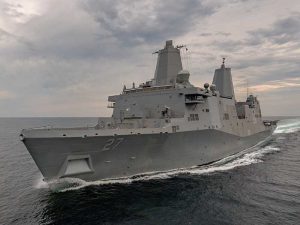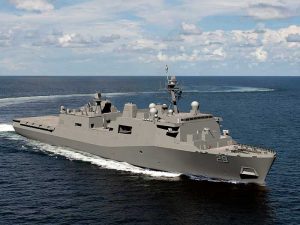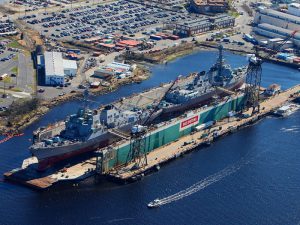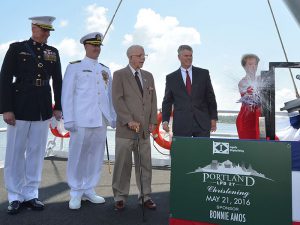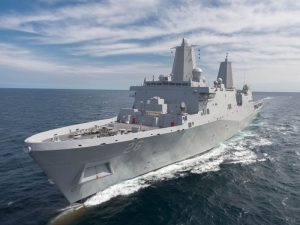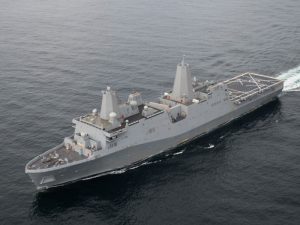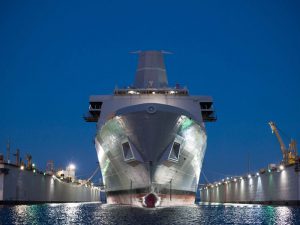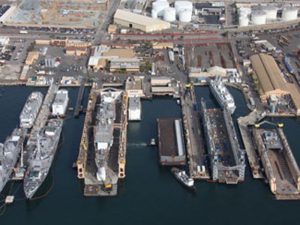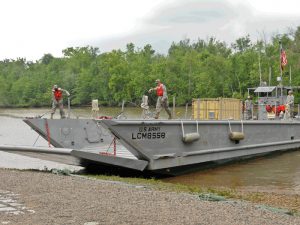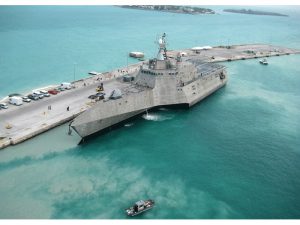In the closing weeks of last year, all sorts of things happened that demonstrated that the way Navy ships actually get ordered is a little different from the way that the process is publicly portrayed.
Things began with the news that the Navy had placed a $200 million advanced procurement contract with Huntington Ingalls Industries’ Ingalls Shipbuilding division for LPD 28, the 12th amphibious transport dock of the San Antonio (LPD 17) class. The fact that there will be a 12th ship in the class illustrates how lobbyists can influence what Navy tonnage gets built—even ships that weren’t ever formally requested in the Navy’s budget submission.
Once that news was announced, the beltway types knew that another shoe would soon drop: an additional DDG 51 destroyer contract for General Dynamics Bath Iron Works.
Defense media predicted that BIW would get the additional destroyer under a “hull swap” agreement in a 2002 MOU between the Navy and its two largest shipbuilders that, among other things, reportedly included an agreement that, should a12th LPD be ordered, a fourth DDG 51-class ship or equivalent workload would be awarded to BIW.
Now where would the money for such a ship come from? We got the answer in the omnibus spending bill that the Congress passed just before Christmas (see this month’s Inside Washington column for more details). If you are to take at face value what they has to say it all happened thanks to Maine’s U.S. Senators.
As the bill was nearing passage, Sen. Susan Collins, a senior member of the Defense Appropriations Committee, and Sen. Angus King, a member of the Senate Armed Services Committee, said that the final omnibus spending bill includes $1 billion toward the construction of an additional DDG 51 destroyer that would “likely” be built at Bath Iron Works and would be in addition to those already included in the current multi-year procurement contract.
The statement issued by the two senators, interestingly, contained no acknowledgement whatsoever that the funding was any kind of pre-arranged “done deal,” widely expected by defense industry insiders.
It said that “as a senior member of the Defense Appropriations Committee, Senator Collins requested the funding toward the additional DDG-51 to help meet combatant commander requirements for destroyers across the globe. Senator Collins successfully advocated for the inclusion of the $1 billion in funding in the Senate Defense Appropriations Bill. The House Defense Appropriations Bill, however, allocated no funding for this additional destroyer. Following weeks of negotiations between the House and Senate regarding the bill, the omnibus bill appropriated the full $1 billion in funding toward this additional ship, affirming the strategic importance of our Navy and shipbuilding programs.”
ANOTHER QUESTION MARK OVER LCS
One of the Navy’s shipbuilding programs that has been evolving has been the Littoral Combat Ship (LCS). As compared with other surface combatants, either variant of the LCS is a small, relatively lower cost, ship. Now, however, it has been decided that future versions of the LCS would be beefed up to become frigates. Under either label, the ship is still affordable enough to enable the Navy to bring up the numbers in its shipbuilding plan to more easily reach its target of a 308-ship battle force.
That plan was thrown into disarray by a December 14 memo sent by Secretary of Defense Ash Carter to Secretary of the Navy Ray Mabus, essentially telling him to rethink the Navy’s budget priorities. Among other things, it directs him to reduce the Navy’s buy of Littoral Combat Ships (including frigatized versions) and to downsize to one of the two variants of the ship.
Before looking at that memo in more detail lets recap on the program as summarized in a recent Congressional Research Service report by veteran analyst Ronald O’Rourke.
“From 2001 to 2014, the program was known simply as the Littoral Combat Ship (LCS) program, and all 52 then-planned ships were referred to as LCSs. In 2014, at the direction of Secretary of Defense Chuck Hagel, the program was restructured. As a result of the restructuring, the final 20 ships in the program (ships 33 through 52), which were to be procured in FY2019 and subsequent fiscal years, were to be built to a revised version of the baseline LCS design, and were to be referred to as frigates rather than LCSs.
“Under this plan, the LCS/Frigate program was to include 24 baseline-design LCSs procured in FY2005-FY2016, 20 frigates to be procured in FY2019 and subsequent fiscal years, and eight transitional LCSs (which might incorporate some but not all of the design modifications intended for the final 20 ships) to be procured in FY2016-FY2018, for a total of 52 ships.”
Two baseline LCS designs are currently being built. One was developed by an industry team led by Lockheed; the other—based on an Austal design—was developed by an industry team led by General Dynamics. The Lockheed design is built at Fincantieri Marine Group’s Marinette Marine shipyard at Marinette, WI; the General Dynamics design is built at the Austal USA shipyard at Mobile, AL, with Austal now also being the prime contractor. Ships 5 through 24 in the program are being procured under a pair of 10-ship block buy contracts that were awarded to the two LCS builders in December 2010.
“The 24th LCS—the first of the three LCSs requested for procurement in FY2016—was to be the final ship to be procured under these block buy contracts, but the contract might be extended to include the 25th and 26th ships (i.e., the second and third ships requested for FY2016) as well,” notes the CRS report.
THE MEMO
The December 14 memo sent by Secretary of Defense Ash Carter to Secretary of the Navy Ray Mabus, not only directs him trim the Navy’s LCS buy of Littoral Combat Ships, but also seems to indicate a very deep divide on what should be the Navy’s budgetary priorities overall.
The memo has already prompted Congressional supporters of the LCS to promise to thwart any attempt to trim the shipbuilding program.
But the memo was leaked and here are some extracts:
“The Navy is critical to our nation’s defense. Recognizing the importance of the fleet, the Department has and will continue to increase the size and capability of the battle force—as the Navy has noted, compared to the 278 ships in 2008, today we have 282 ships in the fleet, and more than 30 are currently under construction. We are well on our way to reaching the 308-ship goal that will meet the Department’s warfighting posture requirement. This requirement should be met, but not irresponsibly exceeded.
“For the last several years, the Department of the Navy has overemphasized resources used to incrementally increase total ship numbers at the expense of critically-needed investments in areas where our adversaries are not standing still, such as strike, ship survivability. electronic warfare. and other capabilities. This has resulted in unacceptable reductions to the weapons, aircraft. and other advanced capabilities that are necessary to defeat and deter advanced adversaries.
“Earlier this year the Department of Defense gave guidance to correct and reverse this trend of prioritizing quantity over lethality; however, counter to that guidance, the Department of the Navy’s latest program submission fails to do so. It is accordingly unbalanced, creates too much warfighting and technical risk, and would exceed the numerical requirement of 308 ships.
“I have made clear in our discussions, in my budgetary guidance, and in public remarks that our military is first and foremost a warfighting force, and while we seek to deter wars, we must also be prepared to fight and win them. This means that overall, the Navy’s strategic future requires focusing more on posture, not only on presence, and more on new capabilities, not only ship numbers.
“The Department’s priorities are 1) to build advanced capabilities, 2) to close growing gaps in naval aviation, and 3) to ensure sufficient ship capacity. To meet these priorities, the Department will build to a total of 40 Littoral Combat Ships (LCS) and frigates (FF), the number that the Navy’s own warfighting analysis says is sufficient to need. This plan reduces, somewhat, the number of LCS available for presence operations, but that need will be met by higher-end ships, and it will ensure that the warfighting forces in our submarine, surface, and aviation fleets have the necessary capabilities and posture to defeat even our most advanced potential adversaries. Under this rebalanced plan, we will still achieve the Navy’s 308-ship goal, we will still. exceed 300 ships in each year from FYI9 to FY30, and we will be better positioned as a force to be overwhelming in posture rather than overextended in presence.
“Specifically, the Department of the Navy will:
Reduce the planned LCS/FF procurement from 52 ships to 40 ships (creating a 1/1/1/1/2 profile for eight fewer ships within the FYDP) by down-selecting LCS/FF production to one variant in FY2019. Forty LCS/FF will exceed recent historical presence levels and will provide a far more modern and capable ship than the patrol coastals, minesweepers, and frigates that they will replace. CAPE will provide specific implementation direction and the decision will be documented in the Resource Management Decision (RMD).
Procure 10 Flight III destroyers (DDGs) within the FYDP. Recognizing the significant capabilities that Flight III destroyers provide, the Department will continue to procure 10 DDGs across the FYDP. In addition, we will upgrade additional Flight IIA DDGs, procure additional advanced electronic warfare capabilities, and invest in munitions that will enable the fleet to hold adversary surface ships at risk. The rebalance will allow us to upgrade a large portion of the current DDG fleet, while still protecting procurement of new DDGs.
“The Navy’s amended budget cuts two submarine combat system upgrades, reduces towed array procurement, and misses a key opportunity to add Virginia Payload Modules (VPM) to our fast attack submarines. VPM is the most cost-effective way to increase the capability and capacity of our submarines; therefore the Navy will invest in an additional Virginia Payload Module in FY20. Waiting until FY20 to procure an additional VPM will provide substantial time to allow the Navy to plan for and execute this increased workload even as production of the Ohio Replacement Program begins. The Department will also restore the two combat system upgrades cut in the Navy’s submission and procure an additional 10 SSN upgrades. These upgrades will ensure we continue to have the most lethal submarine force in the world.”
The memo then spells out a number of things other than ships which Secretary Carter deems needed by the Navy and concludes: “These choices will create a Navy that is far better postured to deter and defeat advanced adversaries, while still continuing to grow the size of the fleet. As both you and I have noted, ship count alone is a poor measure of the effectiveness of the force. With the rebalance laid out this memo, our fleet will not only be larger and more effective than it is today; it will also be equipped with the weapons and capabilities it needs to win any potential war.
“The Department of Defense is relying on the Department of the Navy to support and carry out these critical strategic decisions.”
THE WASHINGTON GAME
Ash Carter has held a number of key Department of Defense posts that began with serving as Assistant Secretary of Defense for International Security Policy during President Clinton’s first term, from 1993 to 1996. He was Under Secretary of Defense for Acquisition, Technology, and Logistics from April 2009 to October 2011, and Deputy Secretary of Defense from October 2011 to December 2013.
So, he knows how the Washington game is played. This has led to speculation that what is playing out here is a tried and tested strategy whereby you don’t budget for the things that you know the Congress will insist on funding anyhow.
The leaking of the memo, which appeared on the Navy League’s website within days of being issued, has already galvanized Alabama congressmen into speaking out loudly in defense of the LCS.
SHIPBUILDING PLAN
You never know what ships exactly will be ordered by the Navy until it makes its budget request—and until that budget has gone through the Congressional grinder. However, the Table below based on the Navy’s FY 2016 budget submission indicates that, at the time that budget was submitted, the intention was for the FY 2017 budget to ask for two Virginia Class submarines, two Arleigh Burke class destroyers, three Littoral Combat Ships, one LHA(R) amphibious assault ship, one Fleet tug/salvage ship (TATS) and Mobile Landing Platform (MLP)/Afloat Forward Staging Base (AFSB).
It will be interesting what actually gets ordered. Even more interesting will be to see what will be in the next rendition of the Navy’s 30 year shipbuilding plan, particularly where LCS/FF numbers are concerned.
